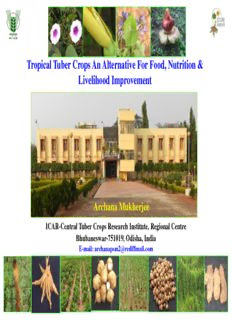
Tropical Tuber Crops An Alternative For Food, Nutrition & Livelihood Improvement PDF
Preview Tropical Tuber Crops An Alternative For Food, Nutrition & Livelihood Improvement
Tropical Tuber Crops An Alternative For Food, Nutrition & Livelihood Improvement Archana Mukherjee ICAR-Central Tuber Crops Research Institute, Regional Centre Bhubaneswar-751019, Odisha, India E-mail: [email protected] SUPER CYCLONE October, 1999, TSUNAMI December 2004 PHAILIN October, 2013 Environmental challenges- issues • India, having more than 6000 km of coastline and many islands, is highly vulnerable to climate change • Rural India including coastal belt - home of 833.10 million in 6,40,867 villages • Food-insecure vast coastal wet lands in India and other countries are prone to frequent cyclones and floods (IPCC) • Shrinking of available arable land and land fragmentation reducing the per capita land availability • Population, poverty and pollution are the haunting issues • Compounding to wide spread poverty, malnutrition & high infant mortality rate • In Odisha state, India, importance of tuber crops revalidated during post super cyclone period as life support crop when all other crops failed to grow Challenges Global Hunger Index (GHI) in India and in its major neighboring countries from 1992 to 2016 Country 1992 2000 2008 2016 India 46.4 38.2 36 28.5 Bangladesh 52.4 38.5 32.4 27.1 China 26.4 15.9 11.5 7.7 Pakistan 43.4 37.8 35.1 33.4 Source: ghi.ifpri.org 2016 Climate resilient crops are the demand of the day (The tropical tuber crops can play significant role) Cassava 386 calories/ 100 g Sweet potato 377 Calories/100 g Why TUBER CROPS ? Taro 361 calories /100 g 370 calories/100 g Yams Elephant Foot Yam 371 calories/100 g Comparative proximate composition of tuber crops to combat hidden hunger Tuber crops Grams per 100 g on dry weight basis Protein Fat Minerals Fibre Carbohydrates Calories Potato 7.3 0.4 2.4 1.6 89.0 382 Sweet potato 3.8 0.9 3.1 2.5 88.5 377 Cassava 1.7 4.9 2.5 1.5 84.9 386 Yam 4.7 0.3 5.3 3.3 86.6 370 Taro 11.6 0.4 6.3 3.7 78.5 361 Elephant foot 5.6 0.5 3.8 3.8 86.3 371 yam Rice 7.8 0.8 0.7 0.2 89.9 397 Wheat 13.5 1.7 1.7 1.4 81.2 393 Concentrations of -carotene, Vitamin C and Vitamin E in sweet potato tubers and other vegetables (Per 100 g fresh. wt.) Vegetable -carotene (mg) Vitamin C (mg) Vitamin E (mg) Sweet potato 1.8-16 23 4.56 Carrots 4-11 6 0.56 Tomatoes 0.64 17 1.22 Tuber crops are hidden treasure and hence needs a proper direction as source for food, nutrition and livelihood. Tropical tubers : source of food, nutrition, feed and allied-industries • The conservation of biodiversity of tuber crops is most important in the context of food insecurity, climate change and organic farming • Tubers of all these crops are also rich in calorie, vitamins and minerals a good source of dietary supplement • Leaves rich in protein, vitamins and minerals are used as fodder • Super cyclone in 1999, Tsunami 2004 (tuber crops as life support sp.) and staple in fragile ecosystems ICAR-CTCRI, Thiruvananthapuram (Kerala) with its Regional Centre in Bhubaneswar (Odisha) working on improving tuber crops technologies and its dissemination across the country Tuber crops grown across the country RF :1790 mm Temp: min max RF : 1750 mm 15 38 Temp : Min Max Soil: Hilly, Red Soil 8 30 Soil: Sandy, Clay Potato Belt loam (Temperate) Cassava RF : 1450 mm RF : 3560 mm Temp: Min Max Temp: min max 8 38 12 37 Soil :Sandy loam Silty Sweet potato Soil : Laterite clay, Alluvial RF : 1050 mm Temp: min max 10 40 Aroids Soil : Sandy loam RF : 3000 mm Temp: min max 19 34 RF : 947 mm Soil : Laterite Temp: min max Yams 17 37 Soil : Red loam Wide adaptive to different agro climatic conditions Road Map Gene pool enrichment (Collection, conservation of diverse genetic resources) Genetic improvement Early maturity High starch, dry matter, high High response to low Tolerance to biotic and carotene, dietary fibres, protein K, P abiotic stresses Evaluation for valued traits (Improved varieties) Implementation Action mode: participatory/outreach KKnnoowwlleeddggee ddiiffffuussiioonn,, mmoottiivvaattiioonn,, hhoouusseehhoolldd ffoooodd--nnuuttrriittiioonn aanndd ssuussttaaiinnaabbllee lliivveelliihhoooodd Linkages with public, private and policy Institutions
Description: